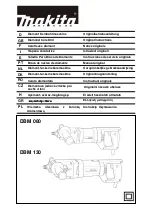
5
begin in the lowest setting (1) and increase gradually until the
desired result is obtained.
• For use as a drill, set the torque adjustment control B to
the drill setting. The clutch is designed not to work in the drill
mode.
CHARGING THE BATTERY
To remove the battery F from the machine, press both side
buttons, G, situated on the handle, at the same time.
To charge the battery with a quick 60 minute charger,
proceed as follows:
1. Place the battery charger I on a flat surface and plug the
charger into the mains.
2. Fit the battery F upside down into the charger. Ensure
that the battery tab is aligned with the inner slot on the
charger. Check that the ter and – of the battery and
the charger coincide. After put-ting the battery in the charger,
you will observe that the red color led J will flash as an
indicator that the battery is charging.
Note: If the flashing frequency of the red color led J is very
fast, or is not constant, it is an indicator that the battery is in
poor condition and should be re-placed.
3. Once the battery charge is completed, the red color led
J of the charger I will remain permanently lit. The battery has
been charged 100% and is ready for use.
4. Once the charge is completed and the red color led J
is lit up, the charger will maintain and balance the charge
level in the different battery cells so it is al-ways ready and
available for use.
Respect the charge time indicated in the table.
Warning! Before charging a battery that has recently been in
use or exposed to direct sunlight or heat, leave it to cool. This
will enable it to be fully recharged.
MAINTENANCE AND CARE
Remove the battery before carrying out any opera-tion on
the machine.
- Clean the machine very carefully after each use. The air
vents should always be kept clear.
- Store in a dry place, away from cold .
- Use only Felisatti accessories and spares. These should
be fitted in a Felisatti technical service centre (See Warranty/
Technical Service Centre address leaflet).
- Brush replacement: The brushes disconnect auto-
matically and should be replaced after 80 - 100 hours use
or when they are less than 3 mm long. Have them replaced
by an Official Service Centre. We re-commend that at every
second change of brushes, you take the machine to one of
our Official Service Centres for general cleaning and oiling.
WARRANTY
See general warranty in separate.
accordance with a standard test method given in EN60745
and may be used for comparing one tool with another.
• The declard vibration total value may also be used in a
preliminary assessment of exposure.
5. A warning
• The vibration emission during actual use of the power tool
can differ from the declared total value depending on the
ways in which the tool is used.
• Identify additional safety measures to protect the operator
that are based on an estimation of exposure in the actual
conditions of use (taking account of all parts of the operating
cycle such as the times when the tool is switched off and
when it is running idle in addition to the trigger time).
USES OF THE MACHINE
• Tightening and loosening screws for metals, screws for
wood, screw that do not require a hole to be drilled previously,
etc.
• Drilling in various types of metal.
• Drilling in various types of wood and plastic.
Any use that differs from the aforementioned is unau-
thorised.
ADJUSTMENTS AND FUNCTIONS
1. Forward/reverse switch
To select the direction of rotation:
• clockwise: push the D selector to the right.
• anti-clockwise: push the D selector to the left.
The anti-clockwise turn enables screws and nuts to be
loosened.
Warning! Only push the forward/reverse switch D when the
machine is switched off.
2. Electronic speed adjustment
The speed can be adjusted continuously, not by stages,
according to the pressure exerted on the on/off switch E, from
the machine being switched off to the highest value for both
speeds, as shown in the table.
This drill is fitted with a reverse-current brake, which stops the
bit when the variable speed control is com-pletely released.
3. Mechanical speed adjustment
These machines are equipped with a two-speed mechanism.
The selector C enables the speed to be adjusted to suit each
use.
• Low speed (1) (lever backwards) for screwdriver action
and drilling ceramics and for starting to drill brick without a
piercer.
• High speed (2) (lever forwards) for drilling brick, for drilling
wood and derivatives, plastics and metals.
The speed can be adjusted while the machine is run-ning.
However, this should not be done at full load. If, when the
machine is stopped, the selector C cannot be set in its final
position, push the on/off E switch briefly.
4. Attachment of bits in the keyless drill chuck
1. Open the drill chuck A and insert the drill bit or screwdriver
bit (in clamp H).
2. To block the bit or screwdriver tip, turn the drill chuck in a
clockwise direction, looking at the ma-chine from the front.
5. Torque adjustment
• For use as a screwdriver, the drill-screwdriver is equipped
with an adjustable clutch, operated by the torque adjustment
control B which has 15 settings. Once it has been correctly
adjusted, the friction clutch is released when the pre-selected
torque setting is reached, to avoid the screw penetrating too
far or damage to the machine. Adjustment depends on the
type and size of the screw used. It is advisable to always






































